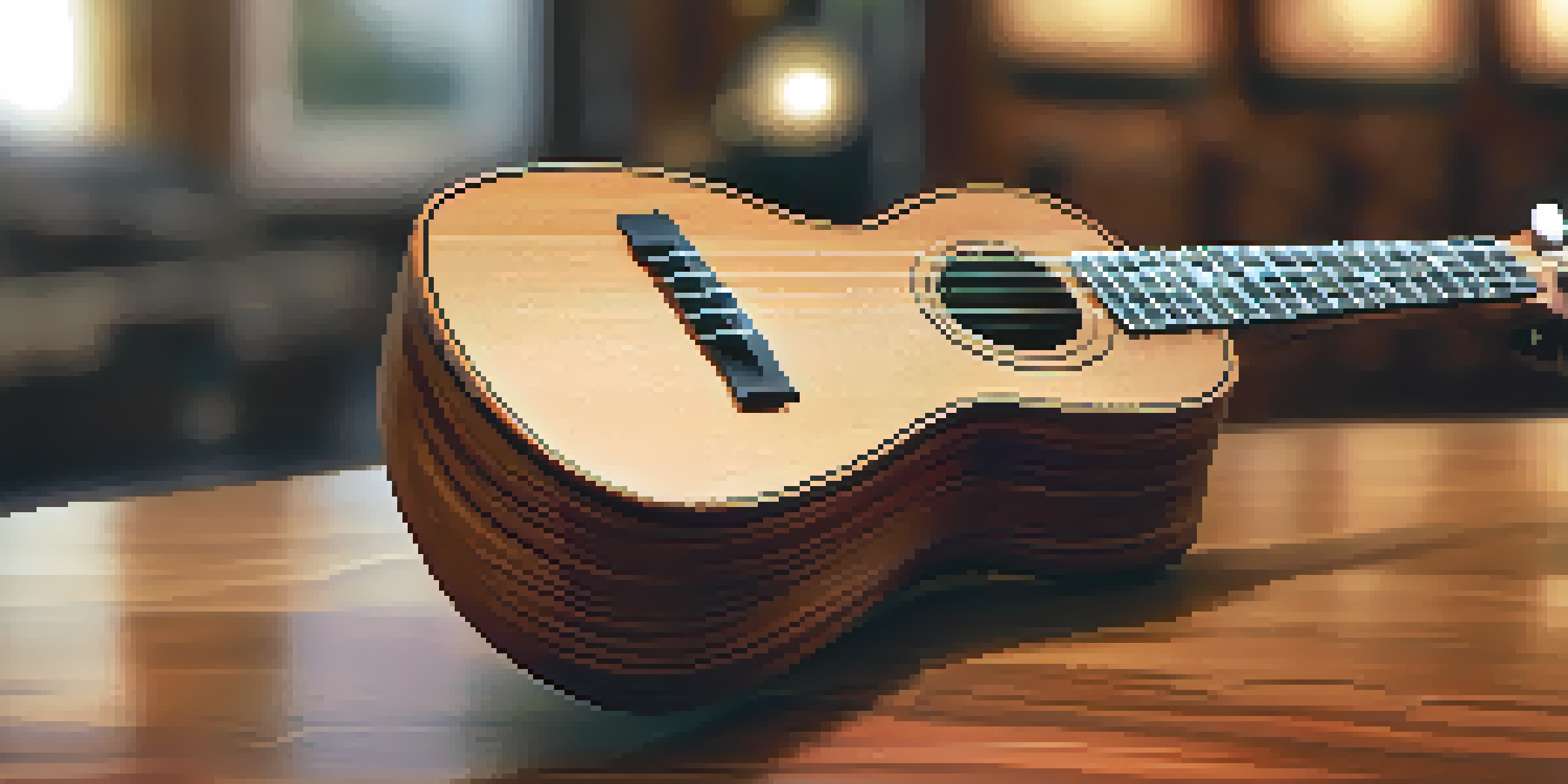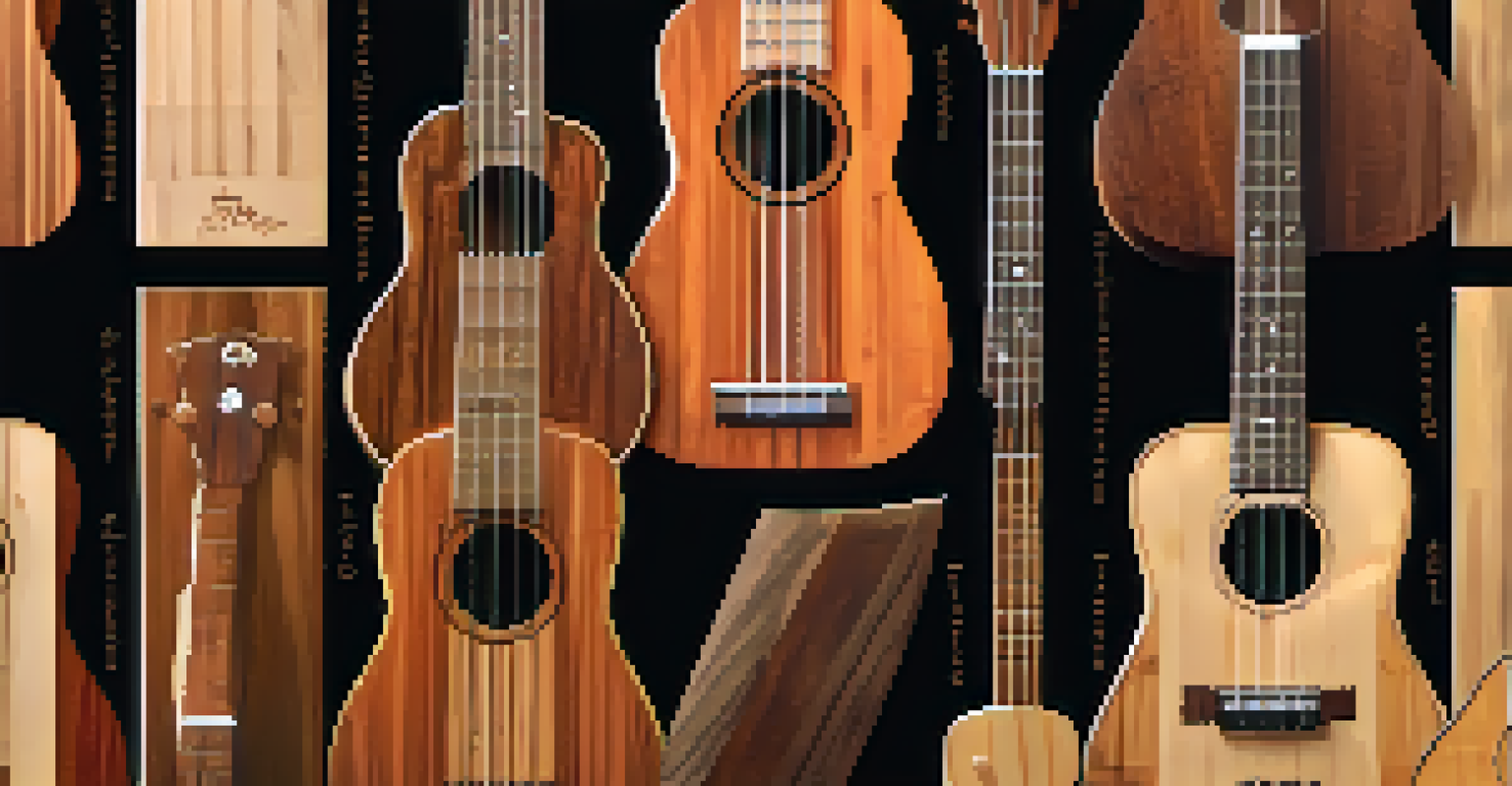Choosing the Right Wood for Your DIY Ukulele Project

Understanding the Importance of Wood Selection
Choosing the right wood is crucial when crafting a ukulele. The type of wood you use affects not only the instrument's sound but also its durability and appearance. Different woods have unique tonal qualities, which can enhance or diminish the overall sound of your ukulele.
The beauty of music is that it connects people, and the ukulele has its own unique way of bringing joy through its sound and playfulness.
For instance, mahogany is popular for its warm tones and rich sound, while spruce is known for its bright, clear sound. Understanding these differences helps you make an informed choice that aligns with your musical preferences. Ultimately, the right wood can make your ukulele a joy to play and listen to.
So, before diving into your DIY project, take the time to explore the characteristics of different woods. This initial step will set the foundation for your entire ukulele-building experience.
Popular Woods for Ukulele Construction
Several woods are commonly used in ukulele construction, each bringing its own flavor to the sound. Mahogany, for example, is favored for its warm, mellow tones, making it a great choice for strumming chords. On the other hand, koa is a traditional Hawaiian wood that offers a beautiful look and a bright, resonant sound.

Spruce is often used for the top of the ukulele due to its excellent projection and clarity. If you’re looking for a more visually striking option, consider maple, known for its stunning grain patterns and bright sound. Each wood choice influences the aesthetics and acoustic properties, so choose wisely.
Wood Choice Affects Sound Quality
The type of wood selected significantly influences the tonal qualities and overall sound of your ukulele.
By exploring these popular options, you can find the wood that resonates with your personal style and sound preferences. This knowledge will guide you in crafting a ukulele that not only sounds good but also feels like an extension of your musical identity.
The Role of Tonewoods in Sound Quality
Tonewoods play a significant role in determining the sound quality of your ukulele. The density, stiffness, and grain of the wood all contribute to how vibrations travel, ultimately influencing the instrument's tone. Softer woods like cedar produce a warm, mellow sound, while harder woods like maple yield a brighter, more focused tone.
The instrument is an extension of your soul; choose the materials that resonate with your spirit.
Understanding the relationship between wood and sound can help you tailor your ukulele to suit your playing style. For example, if you prefer fingerpicking, you might opt for a wood that offers more clarity and projection. On the other hand, if you love to strum, a warmer tonewood may be more appealing.
By selecting the right tonewood, you can create a ukulele that complements your musical expression. This thoughtful consideration can elevate your playing experience and enrich your connection to the instrument.
Considerations for Aesthetics and Finish
Aesthetics are just as important as sound when choosing wood for your ukulele. The visual appeal of the wood, including its grain patterns and color, can enhance the overall beauty of your instrument. Many builders choose woods like koa or rosewood for their striking appearance, which can make your ukulele a true centerpiece.
Additionally, the type of finish you apply can affect both the look and sound of the instrument. A glossy finish can enhance the wood's natural beauty but may alter its tonal qualities. Conversely, a matte finish allows the wood to breathe, often resulting in a more resonant sound.
Aesthetics Matter in Wood Selection
The visual appeal of wood, including grain patterns and finish, enhances the beauty of your ukulele alongside its sound.
By balancing aesthetics with sound quality, you can create a ukulele that not only plays well but also looks stunning. This harmony between form and function can inspire you every time you pick up your instrument.
Budgeting for Quality Wood Choices
When embarking on a DIY ukulele project, it’s essential to budget wisely for quality wood. While it might be tempting to go for cheaper options, investing in good-quality tonewoods can significantly impact the final product. Quality wood typically provides better sound, durability, and aesthetic appeal, making it worth the extra cost.
Consider exploring local suppliers or online shops that specialize in musical instrument woods. This can sometimes yield better prices and more options than generic lumber stores. Additionally, look for reclaimed or sustainably sourced wood, which can be both economical and environmentally friendly.
By budgeting for quality wood, you ensure that your ukulele not only sounds great but also lasts for years to come. This investment pays off in the long run, providing you with an instrument that truly resonates with your musical journey.
Exploring Alternative Wood Options
While traditional woods like mahogany and spruce are popular, there are plenty of alternative options worth considering. For instance, bamboo is gaining traction as a sustainable and eco-friendly choice, offering a unique sound and appearance. It’s lightweight and has a rich tone, making it an exciting alternative for adventurous builders.
Similarly, laminate woods can provide a cost-effective solution without sacrificing too much in terms of sound quality. These woods are engineered to mimic the properties of solid woods, making them a viable choice for beginners or those on a budget. Plus, they’re often more resistant to environmental changes, ensuring consistent performance.
Quality Wood Justifies the Cost
Investing in high-quality tonewoods ensures better sound, durability, and aesthetic appeal for your ukulele.
Exploring these alternative wood options can open up new possibilities for your ukulele project. Each type of wood carries its own characteristics, allowing you to personalize your instrument further.
Final Tips for Choosing the Right Wood
As you embark on your ukulele-building journey, keep a few final tips in mind. First, don’t rush the wood selection process—take your time to research and compare different types. Visit local music shops or luthiers to get a feel for the wood in person; sometimes, the right choice is one that resonates with you emotionally.
Additionally, consider how the wood will perform in the climate where you live. Some woods are more susceptible to humidity and temperature changes, which can affect sound and playability. Make sure to choose woods that are suitable for your local environment.

Finally, trust your instincts. Whether you’re drawn to a specific wood for its sound, appearance, or even a sentimental reason, your personal connection to the wood can enhance your crafting experience. Ultimately, your ukulele should reflect your unique musical style and passion.